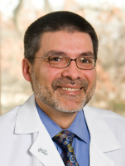| Abstract: |
PURPOSE: To improve skin cancer screening among survivors of childhood cancer treated with radiotherapy where skin cancers make up 58% of all subsequent neoplasms. Less than 30% of survivors currently complete recommended skin cancer screening. PATIENTS AND METHODS: This randomized controlled comparative effectiveness trial evaluated patient and provider activation (PAE + MD) and patient and provider activation with teledermoscopy (PAE + MD + TD) compared with patient activation alone (PAE), which included print materials, text messaging, and a website on skin cancer risk factors and screening behaviors. Seven hundred twenty-eight participants from the Childhood Cancer Survivor Study (median age at baseline 44 years), age > 18 years, treated with radiotherapy as children, and without previous history of skin cancer were randomly assigned (1:1:1). Primary outcomes included receiving a physician skin examination at 12 months and conducting a skin self-examination at 18 months after intervention. RESULTS: Rates of physician skin examinations increased significantly from baseline to 12 months in all three intervention groups: PAE, 24%-39%, relative risk [RR], 1.65, 95% CI, 1.32 to 2.08; PAE + MD, 24% to 39%, RR, 1.56, 95% CI, 1.25 to 1.97; PAE + MD + TD, 24% to 46%, RR, 1.89, 95% CI, 1.51 to 2.37. The increase in rates did not differ between groups (P = .49). Similarly, rates of skin self-examinations increased significantly from baseline to 18 months in all three groups: PAE, 29% to 50%, RR, 1.75, 95% CI, 1.42 to 2.16; PAE + MD, 31% to 58%, RR, 1.85, 95% CI, 1.52 to 2.26; PAE + MD + TD, 29% to 58%, RR, 1.95, 95% CI, 1.59 to 2.40, but the increase in rates did not differ between groups (P = .43). CONCLUSION: Although skin cancer screening rates increased more than 1.5-fold in each of the intervention groups, there were no differences between groups. Any of these interventions, if implemented, could improve skin cancer prevention behaviors among childhood cancer survivors. |




